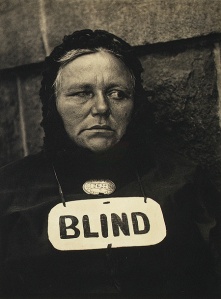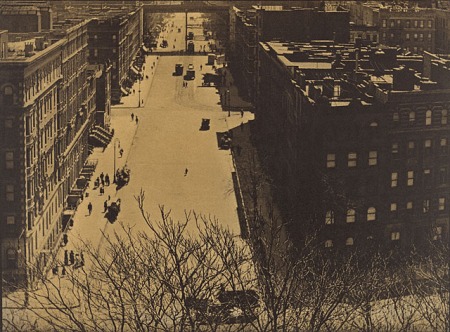Born on the Upper West Side in 1890, Paul Strand became a pioneering filmmaker with his eerie silent Manhatta in 1921, among other motion pictures during his six-decade career.
[Below: American City, 1916]
He’s also one of the first street photographers—credited with establishing photography as an art form in the teens and capturing haunting images of people amid the sleek, dehumanized early 20th century metropolis.
[Below: Wall Street 1915]
Strand’s interest in photography began during his student years at the Ethical Culture School. Photographer and social reformer Lewis Hine was his teacher, and Hine introduced Strand to Alfred Stieglitz and Edward Steichen, artists who greatly influenced Strand’s work.
 Stieglitz soon became a mentor. “In early 1915, his mentor Stieglitz criticized the graphic softness of Strand’s photographs and over the next two years he dramatically changed his technique and made extraordinary photographs on three principal themes: movement in the city, abstractions, and street portraits,” states the website of the Metropolitan Museum of Art.
Stieglitz soon became a mentor. “In early 1915, his mentor Stieglitz criticized the graphic softness of Strand’s photographs and over the next two years he dramatically changed his technique and made extraordinary photographs on three principal themes: movement in the city, abstractions, and street portraits,” states the website of the Metropolitan Museum of Art.
“During the 1910s, New York thronged with pedestrians, carriages, and automobiles, and the streets became the unavoidable symbol of flux, change, and modernity.”
Strand did something revolutionary at the time: he abandoned posed photography in favor of portraits of people unaware of the camera.
[Above: Blind, 1916]
[Above: “Central Park Scene, 1915”]
He stated his reasoning: “I felt that one could get a quality of being through the fact that the person did not know he was being photographed … [and I wanted to capture] these people within an environment which they themselves had chosen to be in, or were in anyway.”
 Strand shot images of the poor, of immigrants, of workers, of the blind and disabled, of aging New Yorkers in parks. His work reveals the humanity amid a modern city on the move, bustling with traffic, crowds, and commerce.
Strand shot images of the poor, of immigrants, of workers, of the blind and disabled, of aging New Yorkers in parks. His work reveals the humanity amid a modern city on the move, bustling with traffic, crowds, and commerce.
“Treating the human condition in the modern urban context, Strand’s photographs are a subversive alternative to the studio portrait of glamour and power,” states the Met.
[Above: Man, Five Points Square, New York, 1916]
“A new kind of portrait akin to a social terrain, they are, as Sanford Schwartz put it, ‘cityscapes that have faces for subjects.'”
See the 10-minute Manhatta here—it’s a treasure.
Tags: New York in the 1910s, Paul Strand Manhatta, Paul Strand photographer, Paul Strand street photos, portraits of New Yorkers 1910s, Street photographers New York City, Wall Street 1915



March 24, 2014 at 11:55 am |
Great piece…what about Charles Sheeler,..what happened to him?There is also another short “Under the dark cloth” that is available with Strand in it…great stuff..
March 24, 2014 at 2:21 pm |
Yes, Charles Sheeler, who Strand made Manhatta with: http://www.metmuseum.org/toah/hd/shee/hd_shee.htm
March 24, 2014 at 12:17 pm |
While watching Paul Strand’s Manhatta, the “ominousness of progress” comes to mind. Thanks for linking to it. I had never seen it before.
March 24, 2014 at 12:17 pm |
Reblogged this on The Quotidian Hudson and commented:
One of the fathers…
March 24, 2014 at 3:48 pm |
A remarkable film in so many ways. Curious about the “tall” building around 4m30s in, and the layered top 5m 30s. Also, lots of steam and smoke. I tried to imagine actually being there, seeing in color, with sound, wind, weather, feeling, soul and thought. How different, yet how not so different from today. And …the hats!!! Thanks for sharing. M
March 24, 2014 at 5:34 pm |
It’s such an evocative snapshot of New York at the time, and I’m surprised it took me so long to post it!
March 25, 2014 at 8:08 am |
[…] [BoweryBoogie] 2. Shots of pre-war Manhattan from street photographer Paul Strand: PHOTOS [EphemeralNewYork] 3. The Lower East Side through a rap lens [Vice] 4. A ginger ale factory grows in […]
June 29, 2015 at 3:45 am |
[…] as a leading photographer who helped elevate photographer to an art form—along with other pioneering picture-takers, like Paul Strand and the more abstract Langdon […]
April 24, 2018 at 7:00 pm |
[…] A pioneering photographer captures the 1910s [Ephemeral NY] […]